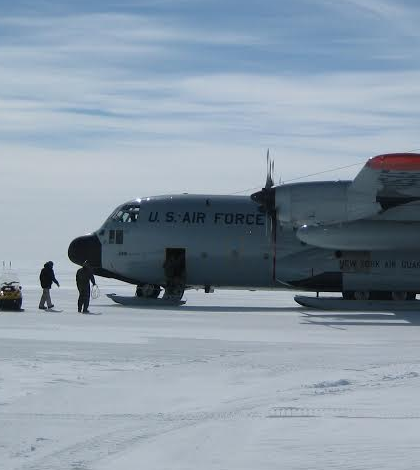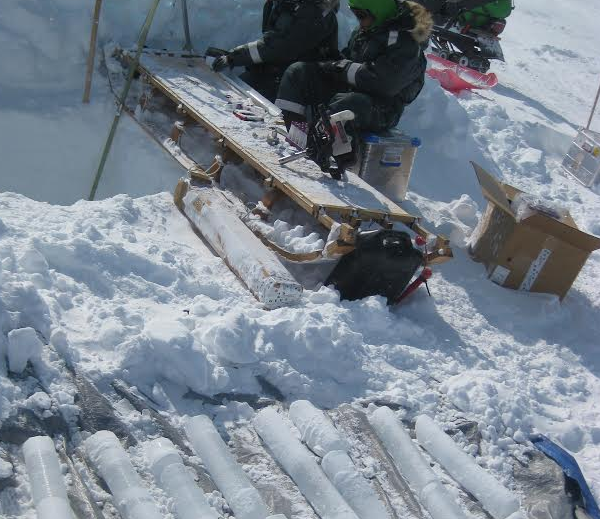Greenland’s Firn Ice Absorbing Less Meltwater

Researchers were transported to the ice sheet by an 109th Air National Guard ski-equipped C-130 Hercules aircraft. (Credit: William Colgan)
Although climate change continues, the planet has some mechanisms to counteract the changes brought on as the temperature creeps higher and higher. One of the changes caused by global warming is a gradual rise in sea level all over the Earth. In the Arctic, a substance called firn ice has acted like a porous sponge for decades, counteracting the gradual rise in sea level by absorbing some of the meltwater produced on the ice sheet each summer.
Firn ice is deep, compacted snow, porous enough to let meltwater seep into it, where it can be refrozen. Recent research, however, has shown that firn ice in Greenland is becoming less absorbent and that sea level is likely to rise faster than projected as a result.
William “Liam” Colgan, assistant professor in the Lassonde School of Engineering at York University, is part of a multinational team of 10 people who have monitored the Arctic firn for years. “We’ve seen definite changes in the structure of firn over time, and they’re not changes for the better. The firn has recently become more ice-filled, so it’s less able to absorb meltwater. The effects of the changes aren’t linear, either, and they likely represent a tipping point where the firn transitions from absorbing meltwater to not absorbing meltwater rather quickly,” Colgan says.
In order to reach Dye-2, Greenland, to drill into the firn to get cores for analysis, the research team relied on the 109th Air National Guard’s C-130 transport planes out of Schenectady, New York, to drop them off on a skiway in the middle of the ice sheet and pick them up again after sampling.
“They use Dye-2 for pilots to practice landing the C-130s on the ice… we just got to go along for the ride!” Colgan says. The U.S. Army Corps of Engineers has a long history of operating at Dye-2, dating back to the early 1960s, when a small radar station was built on the ice sheet as part of the Distant Early Warning (DEW) line.
To investigate the condition of the firn, Colgan and the team drilled 20 meters into it, using a Kovaks firn boring barrel, which has a small gas-powered drill head. The core is drilled and removed 1 meter at a time.

Researchers Dirk van As and Horst Machguth record firn core stratigraphy on the Greenland ice sheet. (Credit: William Colgan)
Many firn cores were taken during the three-year study. Analyzing the firn cores was straightforward, but laborious: Each 1-meter core was cut into 10-centimeter sections with a wood saw for examination, yielding 200 samples per core. Over the study, 15 cores were taken. Core locations were carefully mapped and documented. They also gained information about the firn between core sites by towing a Malå ground-penetrating radar unit towed behind a ski-doo.
“A lot has changed in the firn in the past 20 years,” says Colgan. “It used to be the case that the firn was very absorbent. Meltwater would percolate through it and be absorbed. However, as climate change has continued, substantial refrozen meltwater has begun to accumulate in the firn, meaning there are now layers of solid ice in the firn preventing further meltwater from percolating into the firn. Because meltwater can’t reach the lower layers of the firn anymore, that limits the capacity of the firn to absorb meltwater. Not only does that impact meltwater absorbance today, as the climate continues to warm we expect to get significantly more meltwater. It is likely that future sea-level rise will be significantly higher than it would have been if the firn still had its previous absorbency.”
Currently, ground-penetrating radar they use must be deployed behind a snowmobile at low speed. “We would like to use autonomous rovers in the future, something along the lines of the Yeti robot, to make 2-D grids of the firn maps. That would make monitoring much easier,” Colgan adds. “Automatic core machines would also help with the workload. The oil and gas industry have these, but smaller and more remote programs like ours still cut up cores by hand.”
While Colgan and the team are interested in chemical and isotopic stratigraphy of the firn cores, their primary concern is understanding the density of firn with depth.
This multi-year firn research was jointly led by the University of Colorado at Boulder and the Geological Survey of Denmark and Greenland. The study included many types of research techniques, such as gathering firn core data, interpreting legacy core data, operating ground penetrating radar and collecting weather station data. The Danish Retain program will continue the firn work for the next three years.
Colgan has had many surprises in the years he has conducted firn research in Greenland. “We noticed meltwater channels had migrated inland to higher elevations on the ice sheet over time. Over a one-year period, we saw the headwaters of surface rivers move 5 kilometers inland on the ice sheet, which was a highly visual indicator that the firn was becoming less absorbent,” Colgan says. “There are rivers coursing over the surface now that weren’t there when we started the study. At this rate, there will be lots of surface rivers even further inland on the ice sheet by 2100.”
In addition to the scientific surprises, ice sheet research in general can be shocking to first-timers when they find out how cold it really is.
“A lot of time and energy is spent just doing routine logistical chores: making food, keeping warm, moving camp… all take a lot of effort at such low temperatures. In April it got down to -40 degrees Celsius and our whiskey froze as hard as coal! Now, that’s cold,” Colgan laughs. “It’s a challenging environment for humans but, difficult or not, we’ve got to keep our eye on what’s happening to the firn and preparing ourselves as best we can for the climate changes yet to come.”
Featured Image: Researchers were transported to the ice sheet by an 109th Air National Guard ski-equipped C-130 Hercules aircraft. (Credit: William Colgan)





0 comments